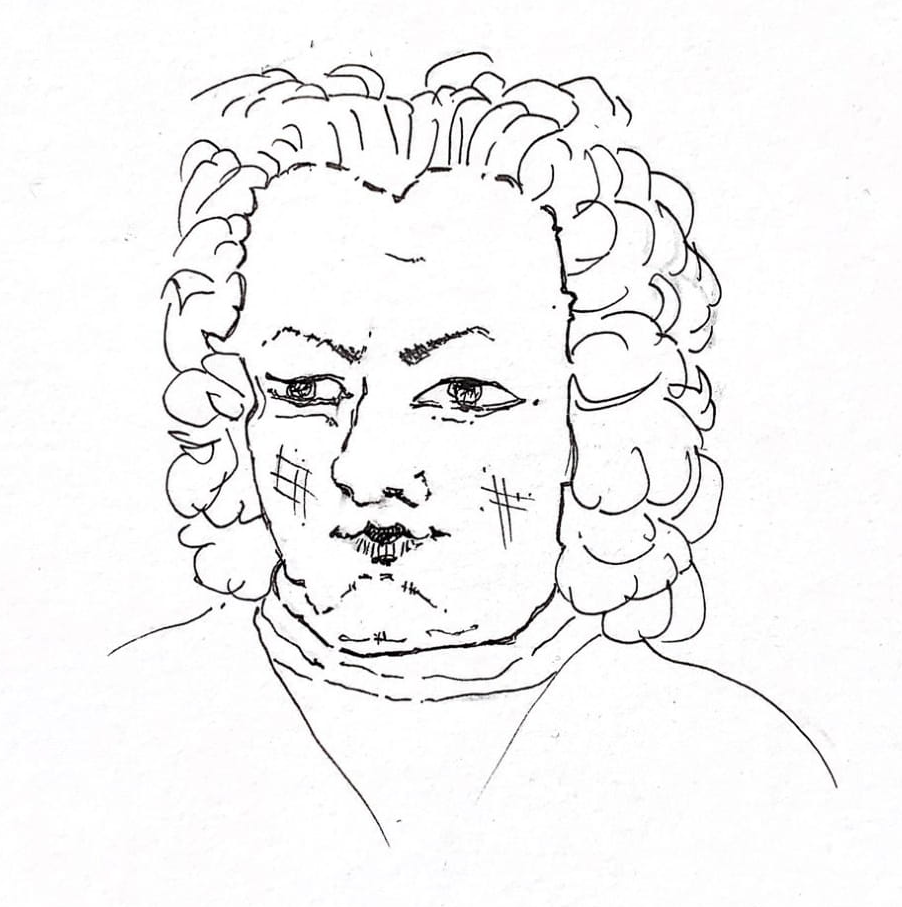Strings and continuo, with 2 flutes and solos, for tenor and alto, an aria for soprano and bass duet and a closing chorus, for 4 part choir.
1/Recitativo:
Exalted flesh and blood, -that God takes upon Himself and, to which, He has, on earth, already assigned, -via a heavenly salvation, to become, His own child.’
A sustained and triumphant tenor, sings this, ‘string-halo-recit’, where ‘…heavenly bliss…’, bar 4, is given to this, now, ‘…exalted flesh and blood…’, bar 6.
2/Aria:
‘A clean soul, sees and tastes, the goodness, of The Lord. Praise, sing and tune-the-strings, in order to spread, God’s goodness.’
This follow-on aria, long, with complex rhythm and abundance of note, French in spirit and charming, in character, seems, at first glance, to be a large musical hammer, swinging, at a relatively small textual nut.
But, a closer, examination, shows us, that this sanctification process, is enabling, a new, ‘seeing’ and ‘tasting’, that is setting, in motion, not only praise and singing, but also, a deeper, laster and growing, re-tuning, of instruments and hearts.
Trite as this might be, it is a fact, that, with dotted, lilting rhythm and filigree detail, this music enacts, a light, delicate, tip-toe dance, with a tasteful, tuned, turn of phrase, all of which reflect in and rejoice at, ‘show-off’, a ‘retuning of hearts’, via elongation and embellishment.
The flute never appears ‘solo’, being forever blended, wind with string, in a combination and one, that blends so well, we seem unable ever to identify either, so well they disappear, into each other.
3/Vivace:
‘Mortals, God wishes, good and great things, for you. Mouth, heart, ear, sight, cannot rest, in all this good fortune and holy joy.’
This is a restless narrative, restless, with the restlessness, of the last line of the text, with its talk, of good fortune and Holy joy.
So is its musical setting, strings, constant and digging-in, staccato, -bar 2 and thereafter, becoming a consistent and controlling, reminder of purpose, until, at ‘…Holy joy…’, an adagio bar, respite, in the form of sustained, chorale-like strings.
But only for a bar.
4/Aria:(duet)
Bass: ‘God so-loved the world, -His mercy helps us, the poor-ones, that He has given us, His son, so that, now, we can partake, of the gifts, of grace, that flow, like deep streams.’
Soprano: ‘His new covenant, of grace, is working and growing, in strength, -and in our hearts and mouths, so that its Spirit, may faithfully teach us, to be faithful and to bring honour, to Him.’
Both: ‘Now, we do our duty, bringing an offering and expressing, thanks, in song. His light inclines to His children and appears, to them, strong and mighty.’
This simple minuet, makes no song-and-dance about anything, but, is just a simple song, a story, of needs met, with thanksgiving and honour, told with simple music and portrayed, with simple tools.
Although the whole is strophic, each verse increases in orchestration and interest.
The 12 bar introduction, although naïf, is not stupid, -note the extra bar, 7, with unexpected hints of a minor, and, in many ways, the bass voice, seems unsuited, out-of-place, in this colour and texture, bottom heavy, in middle-ground tessitura.
An abrupt shift, towards D major, heralds, at last, an independent flute, -in-fact a pair of them.
The new covenant, one of grace, has arrived and these two celebrate, easily and memorably, with quasi and graceful imitation, based on a quaver run, first heard, in violin 1, at bar 4.
As the soprano voice arrives, we remain vert top-heavy, as the top heavy texture thickens.
The continuo drops out and we seem to fly, like a dove, the bird, so often, representative, of the Holy Spirit, loosed from a ground bass and released, into the heights.
Suddenly, 96, semiquavers, taken, from the dotted figure, bar 2, move off, first violin.
These represent, the realisation, of the strong and mighty Father.
What is to be done, at such a revelation? Simple expressions and offerings, of thanks, in song.
5/Recitativo:
‘Everlasting one, -who we call Father, we bring, an offering, from within us, our hearts, which burn, with devotion. The ardour and passion, of our sighs, shall soar, up to heaven.’
These two, soprano and tenor, proceed, homophonically, with seemingly, no particular interest in, or character with, until they arrive at the ‘ardour of sighs’ and ‘soaring to heaven’, where, suddenly, they seem to energise, beautifully and do, just that, 6, through, to the end.
6/Chorus:
‘Stir our spirit, that your gifts, will have their effect, on us. Since your Son commands us to pray, our prayers, will rise, above the clouds, causing you, to hear us.’
In the style of an operatic finale, and with independent flute writing, this final chorus, the only time, in this cantata, where we hear the chorus, at all, shows initiative and character.
Choral imitation, soprano and bass, at 25, orchestral harmonic daring, 37 through 39, extended solo flute writing, 50, through 56.
The daring harmonics, form the basis of the choral section, 66, through 79, the victory over those piercing clouds.
